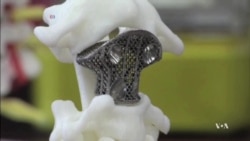A Chinese boy suffering from a debilitating bone disease has become the first patient with a part of his spine created in a three-dimensional printer. Doctors say he will soon regain normal mobility.
Ewing’s sarcoma is a bone cancer that usually attacks children and young adults, causing severe pain. It can lead to deformity and even death.
Twelve-year-old Qin’s second vertebra was so damaged by the cancer that doctors had to remove it.
But instead of replacing it with a simple titanium tube, surgeons made a computer-aided scan of the area and used special software to print a perfect replica on a 3-D printer.
Instead of plastic, this printer uses biocompatible titanium powder, which does not trigger rejection.
The director of orthopedics at Beijing University, who led the surgical team, Dr. Liu Zhongjun, said 3-D printing has a huge advantage for artificial implants.
“We can use iconographic tests on patients such as a CT scan, converting CT data to 3-D printing data in order to produce an internal fixation, with exactly the same structure as the patient's bone structure,” explained Dr. Liu Zhongjun.
The artificial vertebra has a honeycomb structure, which allows the new bone tissue to grow into it, and surgical screws are not needed to attach it.
Qin’s mother, Xu Minglin, said she was worried about the procedure at first.
“In the begining I was a little torn. But in the end, I considered that 3-D has already been applied in the medical world, and they must be confident,” she said.
A month after his surgery, Qin is already able to stand and walk wearing a brace. Doctors say his progress is good and that he will soon recover, although he will have to undergo additional chemotherapy to get rid of any remaining tumor cells.






